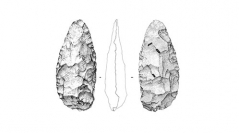

 Comptes Rendus Palevol
16 (2) - Pages 175-181
Comptes Rendus Palevol
16 (2) - Pages 175-181Knapped stone tools constitute an interesting evidence of the mental abilities of their makers. Almost imperishable, they bear visible traces of the successive removals they come from, and of the flaking techniques used. On that basis, we present a few remarkable achievements along the evolution of prehistoric lithic technology, and discuss their capabilities. The tools of the oldest Palaeolithic already surpass the nut cracking from Chimpanzees. Some core reductions into flakes, as early as 2.3 My, show a repeated organization of the removals, and the capacity to prevent a problem. The regular and symmetrical hand-axes from Africa and Europe, appearing between 1 and 0.5 My, provide evidence of a mental template and hence a capacity of conceptualization. The Levalloisian core reduction, somewhat more recent, give evidence of a goal structured method: the technical actions were hierarchized and subordinate to morphological intentions.
Humanization, Lithic technology, Early Palaeolithic, Knapped stone, Technical intelligence